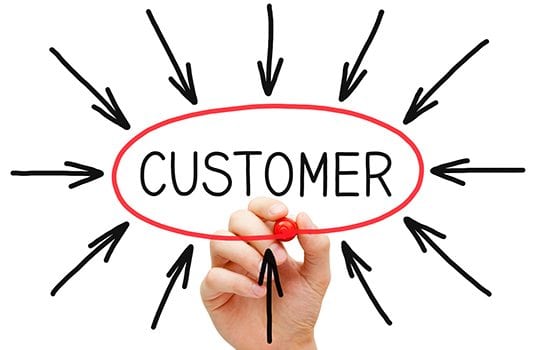By Ann Pitts
Most companies believe delivering memorable, great customer service is an easy thing to accomplish, and automatically assume their customers are being well taken care of by customer service reps. In reality, it’s often a part of the business that could use an extreme overhaul.
In today’s business climate, first class customer service is tougher than ever to achieve, and it’s a fact that customers either stay or go based on their experiences when things go wrong. The cost of getting a new customer is five times the cost of customer retention, so it makes perfect economic sense that customer service is a top competitive advantage.
Why is it so tough to truly give customers the best experience? Is it possible that newer technology, while making companies more efficient, actually gets in the way of delivering the best in customer service? From phone automation to the myriad selection of other software and automation used to run a business, it always comes down to the people—the employees—to create a positive outcome. It’s up to your front line folks to defuse a customer who is unhappy with a problem they might have even created.
Believe it or not, insurance companies are making great strides in improving customer service. That industry has historically been frustrating to deal with when a problem popped up. Issues with insurance companies can originate from so many other sources, it was often tough to track down where the problem started—was it the doctor, coding, hospital, etc.?
Blue Cross Blue Shield has tackled improving its customer service by adding staff and reducing on-hold wait time. Once on the line with a representative, the experience has changed by using technology in a positive manner. Three-way calling has become part of the process. If there’s a problem with a doctor’s office, the rep gets the doctor’s office on the line with the patient also there to resolve the issue. They make every attempt to solve problems while the customer is on the line, even if it means being on hold for a few minutes.
When is the last time your customer service person solved your customer’s problem while they were holding? When a customer calls in with a billing problem, does your customer service staff attempt a three-way call with another employee who can drill down and hopefully resolve the issue quickly? Or does your customer fall into the black hole of voicemail and sticky note follow up?
A recent experience with an airline illustrates the best and the worst in customer service, all taking place within 30 minutes. After purchasing an airline ticket for a business trip, I realized a few hours later that I had not received the standard email confirmation. Logging on to my account, it became apparent I had not completed the transaction, and the trip was not booked. Easy to fix—I logged back in to book the trip but was shocked to see the ticket price had tripled in just a few hours.
I immediately called the airline knowing I was most likely completely responsible for the problem, but hoping there was something they could do to help. Maybe a thread of technology that tied my purchase up, but would be visible and would allow me to complete the ticket purchase at the original price? It was a long shot, but I was a loyal, long-time customer just needing some help.
The first call was a disaster. The customer service rep answered the phone right off the bat with a stern, clipped tone and was quick to point out the problem was my fault; she could offer me nothing. That’s it, we are done here. My questions on how this could’ve happened and why the ticket spiked were of no concern to her, as she didn’t want to discuss or even listen to my questions. After five minutes of getting nothing, I asked to speak to another representative. She replied that no one could help me, and when I persisted she actually hung up the line.
Am I a happy camper or a mad frequent flier, gold status feeling like a non-valued customer?
Calling back immediately, I had a totally different experience. The second customer service rep answered the phone with a calm, confident friendly tone. No rushed, stern clipped voice here. He spent about a minute on the actual problem, not lingering on what I had done wrong but going completely into problem-solving mode. I was no longer marinating in what I had done to create this situation, but was lifted right into “let’s fix this.”
The reason the price tripled was simply supply and demand. The travel-savvy airline employee performed some quick searches and suggested if I could travel to my destination the day before, I could snag that ticket for the original price, and stay in an off-season, reasonably priced hotel. Making the trip the day before originally planned saved me three times as much, even with the extra night hotel stay, and made me a very happy customer. The call took five minutes and the results turned me from an unhappy, out the door to another airline, flier into a problem solved, happy customer.
Taking cues from other industries’ customer service strengths and weaknesses, let’s examine five things that wreck your customer’s experience:
- Employee using an, “I am right, you are wrong and I am bored with the job” tone of voice. If customer service folks are handling 50 customers a day, it’s still important to handle each call with focus, kindness and clarity.
- Telling a customer, “You will have to call the _______ department.” Instead, explain why another department needs to be involved, and facilitate the transfer with a three-way call introducing the customer to the other employee, explaining the issue at hand.
- Using company policy as a road block to help customers. If company policy is legitamitely standing in the way of satisfying an irate customer, be creative and find another way to create the fix. Great customer service providers know there is more than one way to find solutions.
- Employees taking their frustration out on the next customer based on experience with the last customer(s). Customer service staff must be able to shake off one call before going on to the next. Excellent service is not about manuals and policy, but about employee behavior and attitude.
- Technology systems that inhibit, rather than help, customers get their issues heard and solved. Phone and other automation should be fast and efficient, showing ultimate respect for customer’s time. It’s a good idea to call into your own company every now and then, checking auto responders and navigation of the system.
First class customer service is tougher than ever to achieve, but is absolutely essential to a healthy, thriving business. Complaining, unhappy customers can be turned into loyal business partners when handled by employees with the right focus and skill set. Arm customer service reps with tools, knowledge and information for terrific results.
 Ann Pitts is the President of The Pitts Group, a company dedicated to assisting petroleum marketers increase cash flow by improving accounts receivable results. Staff training, sharing of best practices and strengthening company policy are all part of The Pitts Group program. Ann is an experienced business speaker and trainer who has enjoyed focusing on the petroleum industry for over 12 years. Contact Ann via cell at 817-304-1533, or email at [email protected].
Ann Pitts is the President of The Pitts Group, a company dedicated to assisting petroleum marketers increase cash flow by improving accounts receivable results. Staff training, sharing of best practices and strengthening company policy are all part of The Pitts Group program. Ann is an experienced business speaker and trainer who has enjoyed focusing on the petroleum industry for over 12 years. Contact Ann via cell at 817-304-1533, or email at [email protected].








